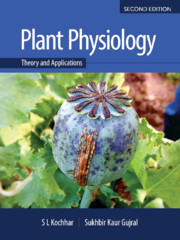Book contents
- Frontmatter
- Contents
- Foreword
- Preface to the Second Edition
- Preface to the First Edition
- Acknowledgements
- Some Common Abbreviations used in the Text
- Abbreviations for Units
- Unit I Water and Mineral Translocation in Plants
- Unit II Metabolism and Bioenergetics
- Unit III Growth and Development
- Unit IV Physiological Stress and Secondary Metabolites – Their Role in Metabolism
- Unit V Crop Physiology – An Innovative Approach
- Unit VI Breakthroughs in Plant Physiology
- Unit VII Some Experimental Exercises
- Glossary
- References
- Index
- Colour Plates
Chapter 19 - Secondary Plant Metabolites
Published online by Cambridge University Press: 12 May 2020
- Frontmatter
- Contents
- Foreword
- Preface to the Second Edition
- Preface to the First Edition
- Acknowledgements
- Some Common Abbreviations used in the Text
- Abbreviations for Units
- Unit I Water and Mineral Translocation in Plants
- Unit II Metabolism and Bioenergetics
- Unit III Growth and Development
- Unit IV Physiological Stress and Secondary Metabolites – Their Role in Metabolism
- Unit V Crop Physiology – An Innovative Approach
- Unit VI Breakthroughs in Plant Physiology
- Unit VII Some Experimental Exercises
- Glossary
- References
- Index
- Colour Plates
Summary
Plants synthesize a vast array of organic compounds that seemingly have no known role in either assimilation or during growth and development of the organism. These compounds, which are natural products, are called secondary metabolites (Figure 19.1). Secondary metabolites are different from primary metabolites (e.g., proteins, lipids, carbohydrates and nucleic acids) because of their restricted distribution in various groups of plants (Figure 19.2). Scientists have long thought that these compounds provide protection to plants from predators and pathogens owing to their toxic effect and repellent nature to herbivores and microbes when studied in vitro. Recent studies have shown that the expression of secondary metabolites can be modified by advanced molecular techniques.
Plant secondary metabolites can be classified into four distinct groups, such as terpenes, phenolics, alkaloids and glycosides.
Terpenes (Terpenoids)
Terpenoids take their name from terpenes, the volatile constituents of turpentine (a solvent produced from the distillation of pine tree resin). These include both primary and secondary metabolites. The terpenes represent the largest group of secondary metabolites. The diverse substances belonging to this group are normally insoluble in water and biosynthesized either from acetyl CoA or intermediates of glycolysis. Terpenoids and their derivatives may be considered polymers of isoprene units which consist of the branched five-carbon isoprene skeleton (Figure 19.3). Consequently, terpenoids are often referred to as isoprenoid compounds. The repetitive 5-C structural motif from which terpenoids are built is called the prenyl group. Terpenes are grouped by the number of 5-C units they have in their skeleton:
Hemiterpenoids: 5-C terpenes (one, five carbon units), e.g., isoamyl alcohol, tiglic acid
Monoterpenoids: 10-C terpenes (two, five carbon units), e.g., geraniol, menthol
Sesquiterpenoids: 15-C terpenes (three, five carbon units), e.g., farnesol
Diterpenoids: 20-C terpenes (four, five carbon units), e.g., phytol (part of chlorophyll)
Sesterpenoids: 25-C terpenes (five, five carbon units), e.g., ophiobolane
Triterpenoids: 30-C terpenes, e.g., steroids and sterol
Tetraterpenoids: 40-C terpenes, e.g., carotenoids
Polyterpenoids: ([C5]n carbons, where n > 8), e.g., natural rubber and gutta
Diterpenoids and triterpenoids include both primary and secondary metabolites. An important chemical group derived from di- and triterpenoid precursors is steroid which is widely distributed in plants, fungi and animals. They contribute much to the stability of membranes and hormone signalling.
- Type
- Chapter
- Information
- Plant PhysiologyTheory and Applications, pp. 590 - 610Publisher: Cambridge University PressPrint publication year: 2020

